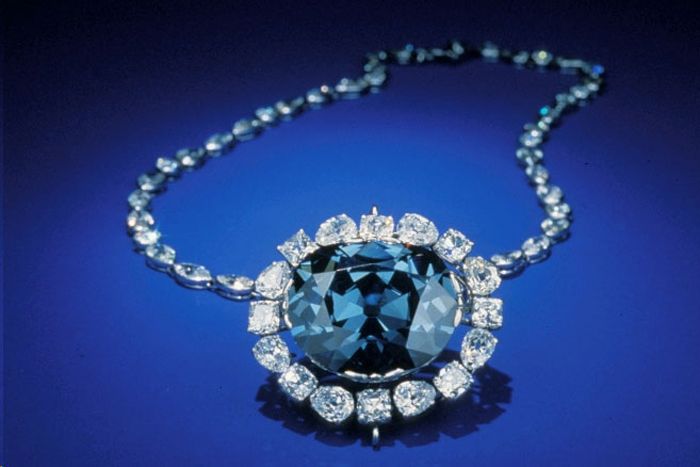Mystery of the Hope Diamond Curse

Diamonds have fascinated mankind for centuries, and it's not surprising that folklore and superstitions have arisen involving good and bad luck associated with them. One of the most spectacular gems in the world is the Hope Diamond, a beautiful blue diamond weighing over 45 carats. About the size of a walnut, the stone is estimated to be worth a quarter of a billion dollars. However, there are many people who would think twice about buying it, for it is said to be cursed.
Karl Shuker, in his book "The Unexplained," relates the origin of this jeopardous gem: "it sparkled in the brow of an Indian temple idol — until it was impiously plucked out by a thieving Hindu priest, whose punishment for this unholy act was a slow and agonizing death. ... It was apparently unearthed in the Golconda mines by the Kistna River in southwest India, and made its European debut in 1642, when it was bought by a French merchant [who sold it to] King Louis XIV for a handsome profit ... but was mauled to death by a pack of wild dogs."
The diamond remained with the French royal family until it was stolen in 1792 during the French Revolution. Louis XIV and Marie Antoinette, who were beheaded, are often cited as victims of the curse. The diamond was missing for a few decades, and was recut into a smaller gem. There are unconfirmed reports that it belonged to Britain's King George IV, whose estate sold it to pay off his enormous debts. In 1839, the diamond was acquired by Henry Thomas Hope, which is how it got its name. After Hope's death, the diamond passed through the hands of several owners.
The misfortune attributed to the diamond would strain the imagination of soap opera writers: Owners committed suicide, were murdered, and left penniless through bad investments. Those who came in contact with the diamond suffered failed marriages, dead children, drug addiction, insanity, and probably bad hair days and paper cuts as well. [Countdown: Real or Not? 6 Famous Historical Curses]
The Hope diamond is the most famous cursed diamond in the world, but it is only one of many. In fact there are dozens of others; according to "The Giant Book of Superstition" by Claudia de Lys, "Diamond superstitions are now found everywhere in the world. A typical Eastern superstition is that the possession of extremely large diamonds always brings misfortune. A long history of blood, theft, intrigue, loss of empire, loss of life and other disasters belongs to each of the most celebrated diamonds, and for the most part the stories are historically true. This fact only strengthens the belief in the minds of the superstitious that large diamonds are the cause of the misfortune of their owners."
Curses!
The Hope curse, it turns out, was more or less a sensational story added by journalists in the late 1800s to sell newspapers. While some of the owners are known to have indeed died bloody deaths (Marie Antoinette's beheading by guillotine being a prime example), many of the other tragedies attributed to the stone have never been confirmed and are little more than rumor.
As with other famous curses, such as the Pharaoh's Curse (also known as King Tut's Curse), a seemingly disastrous history of doom for the Hope diamond can be constructed by simply combing through its history and highlighting anything bad. Since nearly everyone (certainly any adult old and rich enough to own such a precious jewel) has something bad or tragic happen to him or her — from an accident to a disease to a death in the family — it's not difficult to make a list of such events and attribute them to the Hope diamond.
If the curse were simply that whoever owned it would soon die a bloody death, that would be both terrifying and supernatural. However, the Hope diamond curse becomes far less mysterious when we realize that it's not just death but any misfortune (including, apparently, financial ruin, suicide, beheadings, and being eaten by wild dogs) that's included in the legend—and it's not just bad things that afflicted the owners but also their extended families and friends as well. With such a large pool of hundreds of people (and such a broad range of maladies), it would be surprising if a few dozen tragedies hadn't affected people tangentially connected to the Hope diamond over three centuries. [Image Gallery: Two Ancient Curses]
The Hope diamond curse story is in some ways a morality fable about the cardinal sin of greed. The original thief, according to legend, died a slow and painful death, while the later owners, oblivious to the curse until it was too late, suffered as well. It was said that only a person with a pure heart could escape a doomed fate — in this case a "pure heart" meaning someone who did not try to sell it but instead generously gave it away. Thus the curse — if indeed there ever was one — ended when jeweler Harry Winston donated (not sold) it to the Smithsonian Institution in 1958, where it can be seen today.
Benjamin Radford, M.Ed., is Deputy Editor of Skeptical Inquirer science magazine and author of seven books including Scientific Paranormal Investigation: How to Solve Unexplained Mysteries. His website is www.BenjaminRadford.com.
Sign up for the Live Science daily newsletter now
Get the world’s most fascinating discoveries delivered straight to your inbox.













